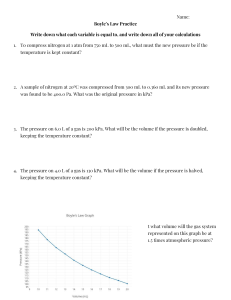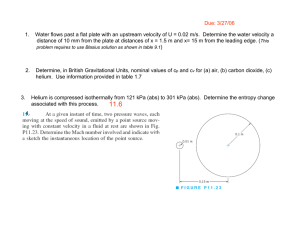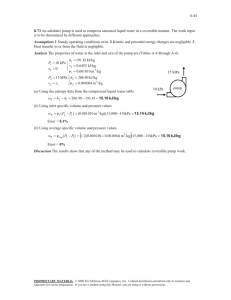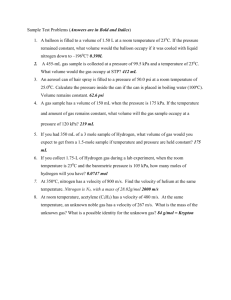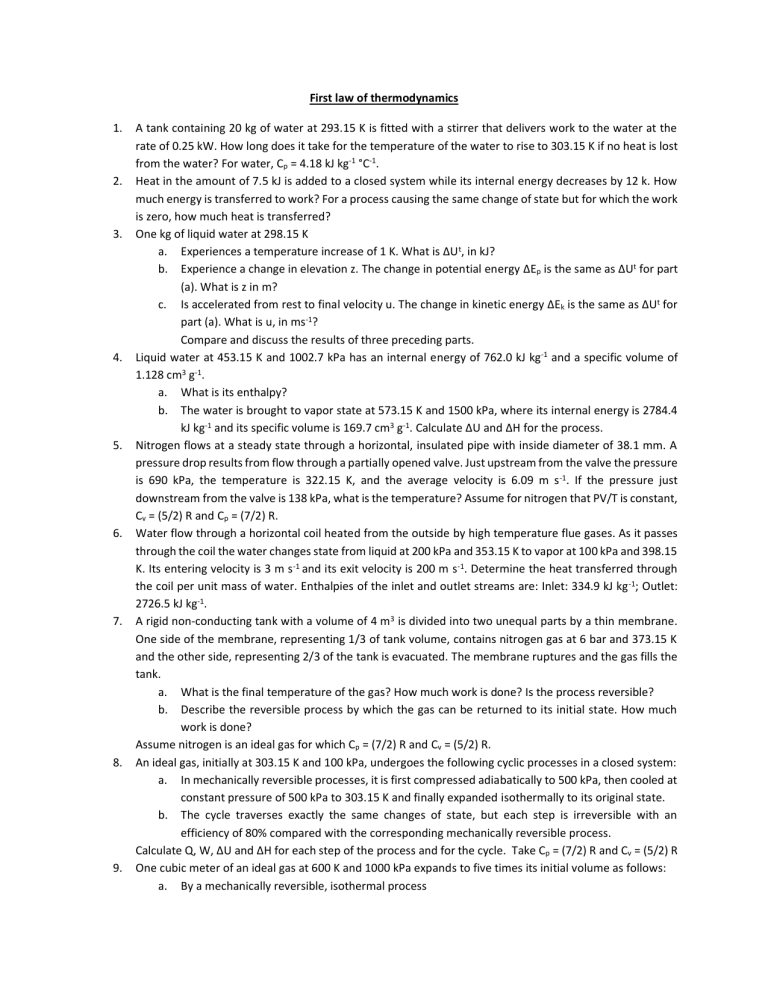
First law of thermodynamics 1. 2. 3. 4. 5. 6. 7. 8. 9. A tank containing 20 kg of water at 293.15 K is fitted with a stirrer that delivers work to the water at the rate of 0.25 kW. How long does it take for the temperature of the water to rise to 303.15 K if no heat is lost from the water? For water, Cp = 4.18 kJ kg-1 °C-1. Heat in the amount of 7.5 kJ is added to a closed system while its internal energy decreases by 12 k. How much energy is transferred to work? For a process causing the same change of state but for which the work is zero, how much heat is transferred? One kg of liquid water at 298.15 K a. Experiences a temperature increase of 1 K. What is ∆U t, in kJ? b. Experience a change in elevation z. The change in potential energy ∆Ep is the same as ∆Ut for part (a). What is z in m? c. Is accelerated from rest to final velocity u. The change in kinetic energy ∆Ek is the same as ∆Ut for part (a). What is u, in ms-1? Compare and discuss the results of three preceding parts. Liquid water at 453.15 K and 1002.7 kPa has an internal energy of 762.0 kJ kg-1 and a specific volume of 1.128 cm3 g-1. a. What is its enthalpy? b. The water is brought to vapor state at 573.15 K and 1500 kPa, where its internal energy is 2784.4 kJ kg-1 and its specific volume is 169.7 cm3 g-1. Calculate ∆U and ∆H for the process. Nitrogen flows at a steady state through a horizontal, insulated pipe with inside diameter of 38.1 mm. A pressure drop results from flow through a partially opened valve. Just upstream from the valve the pressure is 690 kPa, the temperature is 322.15 K, and the average velocity is 6.09 m s -1. If the pressure just downstream from the valve is 138 kPa, what is the temperature? Assume for nitrogen that PV/T is constant, Cv = (5/2) R and Cp = (7/2) R. Water flow through a horizontal coil heated from the outside by high temperature flue gases. As it passes through the coil the water changes state from liquid at 200 kPa and 353.15 K to vapor at 100 kPa and 398.15 K. Its entering velocity is 3 m s-1 and its exit velocity is 200 m s-1. Determine the heat transferred through the coil per unit mass of water. Enthalpies of the inlet and outlet streams are: Inlet: 334.9 kJ kg -1; Outlet: 2726.5 kJ kg-1. A rigid non-conducting tank with a volume of 4 m3 is divided into two unequal parts by a thin membrane. One side of the membrane, representing 1/3 of tank volume, contains nitrogen gas at 6 bar and 373.15 K and the other side, representing 2/3 of the tank is evacuated. The membrane ruptures and the gas fills the tank. a. What is the final temperature of the gas? How much work is done? Is the process reversible? b. Describe the reversible process by which the gas can be returned to its initial state. How much work is done? Assume nitrogen is an ideal gas for which Cp = (7/2) R and Cv = (5/2) R. An ideal gas, initially at 303.15 K and 100 kPa, undergoes the following cyclic processes in a closed system: a. In mechanically reversible processes, it is first compressed adiabatically to 500 kPa, then cooled at constant pressure of 500 kPa to 303.15 K and finally expanded isothermally to its original state. b. The cycle traverses exactly the same changes of state, but each step is irreversible with an efficiency of 80% compared with the corresponding mechanically reversible process. Calculate Q, W, ∆U and ∆H for each step of the process and for the cycle. Take Cp = (7/2) R and Cv = (5/2) R One cubic meter of an ideal gas at 600 K and 1000 kPa expands to five times its initial volume as follows: a. By a mechanically reversible, isothermal process 10. 11. 12. 13. 14. b. By a mechanically reversible, adiabatic process c. By an adiabatic, irreversible process in which expansion is against a restraining pressure if 100 kPa. For each case calculate the final temperature, pressure and the work done by the gas. Cp = 21 J mol-1 K-1. One mole of air initially at 423.15 K and 8 bar, undergoes the following mechanically reversible changes. It expands isothermally to a pressure such that when it is cooled at constant volume to 323.15 K its final pressure is 3 bar. Assuming air is an ideal gas for which Cp = (7/2) R and Cv = (5/2) R, calculate W, Q, ∆U and ∆H. An ideal gas flowing through a horizontal tube at steady state. No heat is added and no shaft work is done. The cross sectional area of the tube changes with length and this causes the velocity to change. Derive and equation relating the temperature to the velocity of the gas. If nitrogen at 423.15 K flows past one section of the tube at velocity of 2.5 ms-1, what is its temperature at another section where its velocity is 50 m s -1? Let Cp = (7/2) R. One mole of an ideal gas, initially at 303.15 K and 1 bar, is changed to 403.15 K and 10 bar by three different mechanically reversible processes: a. The gas is first heated at constant volume until its temperature is 403.15 K; then it is compressed isothermally until its pressure is 10 bar. b. The gas is first heated at constant pressure until its temperature is 403.15 K; then it is compressed isothermally to 10 bar. c. The gas is first compressed isothermally to 10 bar; then it is heated at constant pressure to 403.15 K. Calculate Q, W, ∆U and ∆H in each case. Take Cp = (7/2) R and Cv = (5/2) R. Alternatively take Cp = (5/2) R and Cv = (3/2) R. One mole of an ideal gas, initially at 303.15 K and 1 bar, undergoes the following mechanically reversible changes. It is compressed isothermally to a point such that when it is heated at constant volume to 393.15 K its final pressure is 12 bar. Calculate Q, W, ∆U and ∆H for the process. Take Cp = (7/2) R and Cv = (5/2) R. A process consists of two steps: (1) One kmol of air at 800 K and 4 bar is cooled at constant volume to 350 K. (2) The air is then heated at constant pressure until its temperature reaches 800 K. If this two step process is replaced by a single isothermal expansion of the air from 800 K and 4 bar to some final pressure P, what is the value of P that makes the work of the two processes the same? Assume mechanical reversibility and treat air as an ideal gas with Cp = (7/2) R and Cv = (5/2) R.
